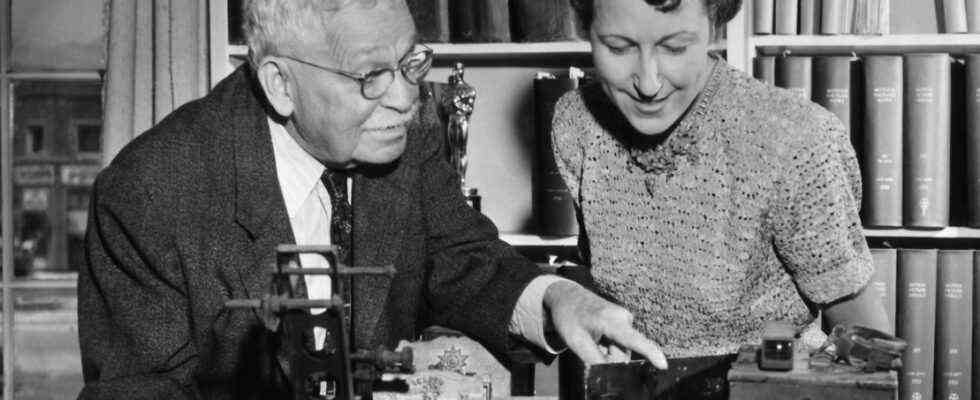What do a film camera and a sausage machine have in common? When the film producer William Selig visits Chicago’s largest slaughterhouse at the beginning of the 20th century, a tainted young man in a butcher’s apron runs after him and begs him to record the work of the sausage machine with his camera: No advertising for the Armor slaughterhouse, but the one Please explain the new medium of Lichtspiel about the production of Armor sausages! Her secret recipe: “Take what’s on the dustpan, including spit and sawdust, knead it with gristle, bone meal and last year’s sausage, stir in borax and glycerine and push it through the machine. With rats and rat poison and whatever Anything else that fell into the funnel. For example, the skin from the hands of the men in the curing hall. It goes off in the brine. Oh – and did you know that tuberculous cattle get fat faster? “
“No”, answers Selig in the novel “Selig & Boggs” by Christine Wunnicke, which can now be read again in a particularly elegant new edition. “The light show is the people’s enlightener of the future!” Says the man hopefully: “‘Oh’, said Selig.”
In the young butcher you can recognize Upton Sinclair, whose early anti-capitalist-apocalyptic pig vision landed in the novel “The Jungle”. The new medium of film, on the other hand, operated in a similar way to the sausage machine. He swallowed all the rubbish that otherwise made no sense of culture or society. William Nicholas Selig had already trundled through the American South in the 1890s and worked his way up from a house mechanic to a miracle healer to a salon magician. Then he toured with his own minstrelshow over fairs, national shows, theaters and brothels, until one day he was enchanted himself: while looking at the jerky movements of photographs in a mahogany cupboard, called Nickelodeon. Blessed became a pioneer in American film production.
Everything becomes a film that leans against cardboard pillars or slips on soft soap
As always in Christine Wunnicke’s grotesque historical short novels, a second original lurks as a distorted copy of the first in the next plot fold: We experience the director Francis Boggs right in the middle of his work. This essentially consists of shouting “stop, stop stop” and “stop recording” because once again a dark cloud is erasing the scene, at least for the camera, which is always carried around as close as possible to the object.
That cannot happen to the clever author, even if she jumps from close-up to close-up, with ludicrously cheeky cuts. But Boggs also knows how to give a helping hand to the cultural history of the 20th century by moving to California under the eternal sun with a crank camera and artificial beards.
Here as there and on the way west, everything that stands, goes and falls, what can wear a hat, a toga or a cowboy vest, what leans against cardboard pillars or slips on soft soap becomes a film. In any case, the day’s waste composted for the film and its dreams are closer to the crooked banana peel than to the upright walk of the Enlightenment. At first glance, this also seems to apply to the wandering, anarchic, anecdotal scenes and anecdotes. But far from it. Not only is Christine Wunnicke in control of her precisely researched and composed historical material at all times, she also follows the episodic concrete structure of the early film, which usually lasted only a few minutes. One or two films were shot with three or four people a day. Similarly, “Selig & Boggs” would consist of fourteen short films.
Even more, she manages to loosely link the media technology revolution of film with the philosophical question of the nature of the symbol. “Seligs Polyscope”, the starting point of Hollywood, is not in the holly forest, but in the Edendale district. Paradise, in which biblically things and their names coincide, is invoked again and again. What does the “salvation of external reality” (Siegfried Kracauer) achieve in the film for the convergence of symbols and objects? A hundred and twenty years and one media revolution on, we encounter here one of the cleverest and most attractive formulations of this anthropological question.
Christine Wunnicke: Selig & Boggs. The invention of Hollywood. Novel. Berenberg, Berlin 2013/2021. 128 pages, 14 euros.
The animals play an important role. Blessedly loves them all. He goes out on the balcony with a chimpanzee to smoke with him. He has five elephants, two giraffes, seven bears, six elks, four kangaroos, two yaks, forty-nine monkeys, birds. And the Polyscope is in the middle of paradise, in the zoo that will later become the core of the Los Angeles Zoo.
Selig lives at home with leopards that have been kissed a lot and a lion named Jackie, who gently and moistly bruises his knuckles. We all know him. Jackie has grown old and pomadig twice weakly shouted in front of the specially set up camera: the signet of Metro Goldwyn Meyer. By then, Selig was already broke and largely forgotten. He just didn’t think it was possible that films would last longer than half an hour. The fact that DW Griffith celebrated a huge success right next door with his several hours of historical drama “Intolerance” is another story. Wunnicke’s “Selig & Boggs” relates to it like pre- and parahistory to meaningful history.

